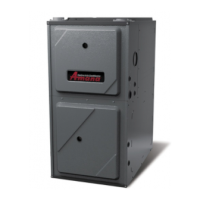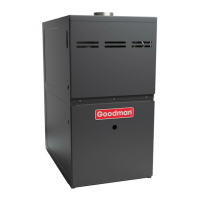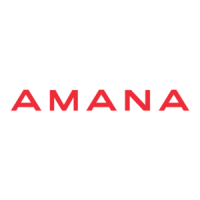SYSTEM OPERATION
8
American National Standards Institute
25 West 43
rd
Street, 4
th
Floor
New York, NY 10036
National Fire Protection Association
1 Batterymarch Park
Quincy, MA 02169-7471
CSA International
8501 East Pleasant Valley
Cleveland, OH 44131
A copy of the CAN/CGA B149 Installation Codes can be
obtained from:
CSA International
178 Rexdale Boulevard
Etobicoke, Ontario, Canada M9W, 1R3
The rated heating capacity of the furnace should be greater
than or equal to the total heat loss of the area to be heated.
The total heat loss should be calculated by an approved
method or in accordance with “ASHRAE Guide” or “Manual
J-Load Calculations” published by the Air Conditioning
Contractors of America.
WARNING
PREVEN PSSILE EQIPMEN DAMAGE PRPER DAMAGE PERSNAL
INJR R DEA E LLWING LLE PINS MS E SERVED
WEN INSALLING E NI
Follow the instructions listed below when selecting a
furnace location. Refer also to the guidelines provided in the
Combustion and Ventilation Air Requirements section in this
manual or the installation instructions for details.
• Centrally locate the furnace with respect to the proposed
or existing air distribution system.
• Ensure the temperature of the return air entering the
furnace is between 55°F and 100°F when the furnace
is heating.
• If the furnace is installed in an application where the
typical operating sound level of a furnace is deemed
objectionable, an optional sound reduction kit is
available. Consult your local distributor for more details.
• Provide provisions for venting combustion products
outdoors through a proper venting system. Special
consideration should be given to vent/ue pipe routing
and combustion air intake pipe when applicable.
• Refer to the Vent/Flue Pipe and
Combustion Air Pipe -Termination Locations section in
this manual or the installation instructions for appropriate
termination locations. Also for 90% furnaces, refer to the
Vent/Flue Pipe and Combustion Air Pipe -Termination
Locations section in this manual or the installation
instructions to determine if the piping system from
furnace to termination can be accomplished within
the guidelines given The length of ue and/
or combustion air piping can be a limiting factor in the
location of the furnace.
• Locate the 90% furnace so that the condensate can be
piped at a downward slope away from the furnace to
the drain. Do not locate the furnace or its condensate
drainage system in any area subject to below freezing
temperatures without proper freeze protection. Refer
to the Condensate Drain Lines and Trap section in this
manual or the installation instructions for further details.
• Set the 90% furnace on a level oor to enable proper
condensate drainage. If the oor becomes wet or damp
at times, place the furnace above the oor on a concrete
base sized approximately 1-1/2” larger than the base
of the furnace. Refer to the Horizontal Applications and
Considerations section in this manual or the installation
instructions for leveling of horizontal furnaces.
• Ensure upow or horizontal furnaces are not installed
directly on carpeting, or any other combustible material.
The only combustible material allowed is wood.
• A special accessory subbase must be used for upright
counterflow unit installations over any combustible
material (including wood). Refer to subbase instructions
for installation details. (N A subbase will not be
required if an air conditioning coil is located beneath
the furnace between the supply air opening and the
combustible oor.
• Exposure to contaminated combustion air will result in
safety and performance-related problems. Do not install
the furnace where the combustion air is exposed to the
following substances:
chlorinated waxes or cleaners
chlorine-based swimming pool chemicals
water softening chemicals
deicing salts or chemicals
carbon tetrachloride
halogen type refrigerants
cleaning solutions (such as perchloroethylene)
printing inks
paint removers
varnishes
hydrochloric acid
cements and glues
antistatic fabric softeners for clothes dryers
and masonry acid washing materials
• Isolate a nondirect furnace from an area contaminated
by any of the above substances. This protects the
non-direct vent furnace from airborne contaminants. To
ensure that the enclosed non-direct vent furnace has an
adequate supply of combustion air, vent from a nearby
uncontaminated room or from outdoors. Refer to the

